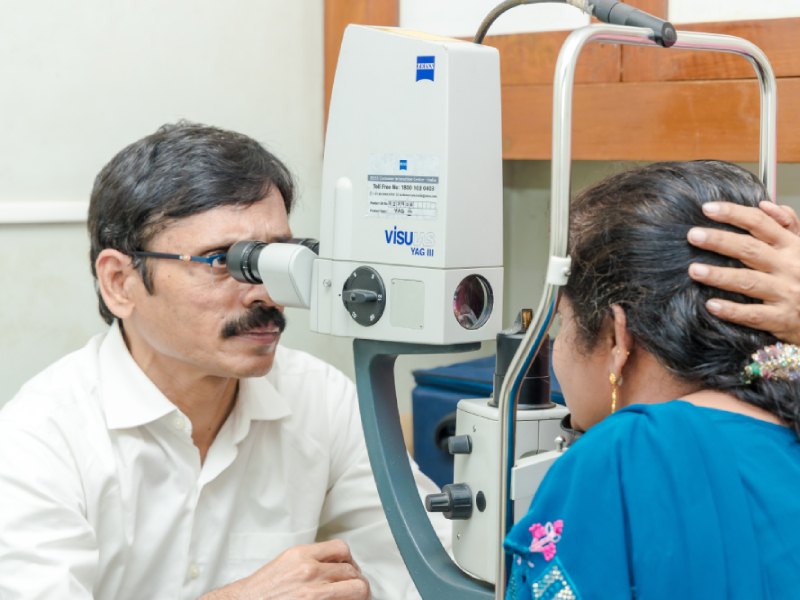GLAUCOMA
One of the leading causes of irreversible blindness…
Glaucoma is the second commonest cause for irreversible blindness and is often known as the “silent thief of sight” as patients commonly have no symptoms in the initial stages. Only as the disease progresses do they complain of visual problems, leading to late patient presentation. But by then already permanent nerve damage might have happened & it won’t be reversible. One of the commonest reason for Glaucoma is stated to be increased IOP (Intra Ocular Pressure) which is seen mainly due to genetic & other factors. At Shankar’s we mandatorily check IOP for all our patients (excluding Paediatric age group) for routine check-ups.
One of the most commonly asked question by the patients is, “Is glaucoma curable?”
Glaucoma unfortunately is not curable and causes irreversible blindness. This therefore highlights the importance of early detection and treatment to preserve useful vision. Glaucoma is a lifelong disease which requires regular monitoring and lifelong follow up.
You may have higher chance of getting glaucoma if you:
- Have increased IOP in your eyes
- Family History of Glaucoma
- Systemic diseases such as diabetes mellitus,hypertension,heart disease
- Age more than 40 years
- Had an eye injury or surgery
- Use steroid medicines for a long time
All the preliminary investigations to r/o Glaucoma, like Applanation Tonometry (Haag Streit, Germany) & NCT (Topcon, Japan), CCT (Topcon, Japan), Gonioscopy are routinely performed at our centres, thereby eliminating the tiniest errors.

HFA MACHINE (Carl Zeiss, Germany) : Glaucoma causes peripheral field of visual loss initially (which is also regarded as a reason for late patient presentation) This test will help your doctor measure your peripheral vision by which you can diagnose and monitor glaucoma. The data from the test is used to determine the severity of your glaucoma, level of vision loss, damage to the visual pathways of the brain, and other optic nerve diseases.
OCT Machine (Carl Zeiss, Germany) : Glaucoma is detected at its earliest stage only by advanced investigations which include OCT RNFL (Ocular nerve head imaging). Regarding Glaucoma treatment, the old saying of earlier the better holds true. Hence detection of early Glaucoma holds key. At all of our branches, we have equipped with one of the most advanced OCT machine (Carl Zeiss,Germany)


Specular Microscope : A specular microscope is a crucial tool in the diagnosis and monitoring of glaucoma. This non-invasive imaging device provides detailed images of the corneal endothelium, enabling ophthalmologists to assess cell density, shape, and overall health. In glaucoma patients, the health of the cornea can be affected, especially due to prolonged elevated intraocular pressure. The specular microscope allows for early detection of corneal damage, ensuring timely intervention and personalized treatment plans. By capturing high-resolution images, it enhances the accuracy of glaucoma management and helps preserve vision.
Based on the results of these tests, we will make a plan to treat your glaucoma. There are both Medical management & Surgical options to treat glaucoma, depending on the severity and what works best for you. Some of the treatments options are:
- Eye drops that lower the pressure in your eyes
- Laser therapy
- Surgery that creates a new way for the fluid to leave your eye
Treatment for Glaucoma
Treatment options are aimed at preserving existing vision and preventing further loss of vision.
LASER TREATMENT FOR GLAUCOMA
Laser treatment, offered by Shankar’s eye hospital, can be a valuable tool in your treatment plan. But do you need it? Let's explore this option together.
Do I need laser treatment for my glaucoma?
Laser treatment aims to improve drainage of aqueous humor, the fluid within your eye, thus reducing eye pressure. Several types of laser procedures exist, each with its benefits and limitations:
- Selective Laser Trabeculoplasty (SLT): This minimally invasive procedure stimulates the drainage channels, often used for early-stage glaucoma. This laser is one of the recent advances in the field of Glaucoma management. We are proud to say that Shankar’s Eye Hospital, Punalur is equipped with South Kerala’s FIRST SLT LASER MACHINE (Carl-Zeiss, Germany)

- Laser Peripheral Iridectomy (LPI): Creates a tiny hole in the iris to improve fluid flow, primarily used for angle-closure glaucoma in which there will be often sudden increase of IOP (Intra ocular pressure) thereby reducing IOP. At Shankar’s Eye Hospital, Punalur we use only Carl-Zeiss Laser Machine which is often considered as gold standard laser machine among ophthalmologists.

SURGICAL TREATMENT
- Glaucoma Surgery: Often surgery is the last option in the treatment of Glaucoma & is performed only when all other treatment options fail to control the spread of glaucoma. However surgical option is the first choice in treating Advanced Glaucoma as there is no role of lasers/eye drops. At Shankar’s Hospital, Punalur we routinely perform glaucoma surgeries like Trabeculectomy (with or without cataract) and Trabeculotomy.